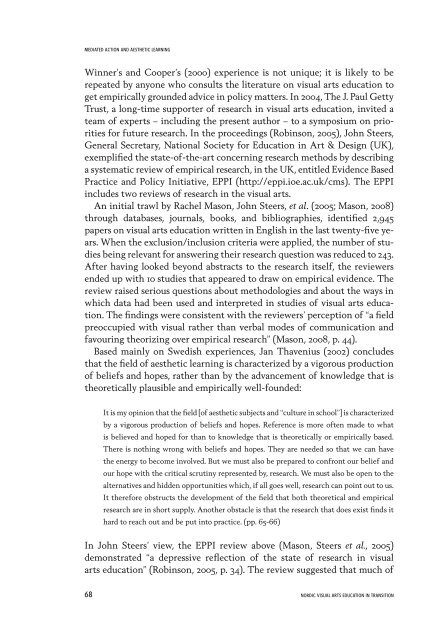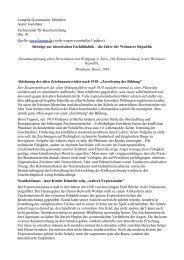Research in Visual Arts Education - The National Society for ...
Research in Visual Arts Education - The National Society for ...
Research in Visual Arts Education - The National Society for ...
You also want an ePaper? Increase the reach of your titles
YUMPU automatically turns print PDFs into web optimized ePapers that Google loves.
MEDIATED ACTION AND AESTHETIC LEARNING<br />
W<strong>in</strong>ner’s and Cooper’s (2000) experience is not unique; it is likely to be<br />
repeated by anyone who consults the literature on visual arts education to<br />
get empirically grounded advice <strong>in</strong> policy matters. In 2004, <strong>The</strong> J. Paul Getty<br />
Trust, a long-time supporter of research <strong>in</strong> visual arts education, <strong>in</strong>vited a<br />
team of experts – <strong>in</strong>clud<strong>in</strong>g the present author – to a symposium on priorities<br />
<strong>for</strong> future research. In the proceed<strong>in</strong>gs (Rob<strong>in</strong>son, 2005), John Steers,<br />
General Secretary, <strong>National</strong> <strong>Society</strong> <strong>for</strong> <strong>Education</strong> <strong>in</strong> Art & Design (UK),<br />
exemplified the state-of-the-art concern<strong>in</strong>g research methods by describ<strong>in</strong>g<br />
a systematic review of empirical research, <strong>in</strong> the UK, entitled Evidence Based<br />
Practice and Policy Initiative, EPPI (http://eppi.ioe.ac.uk/cms). <strong>The</strong> EPPI<br />
<strong>in</strong>cludes two reviews of research <strong>in</strong> the visual arts.<br />
An <strong>in</strong>itial trawl by Rachel Mason, John Steers, et al. (2005; Mason, 2008)<br />
through databases, journals, books, and bibliographies, identified 2,945<br />
papers on visual arts education written <strong>in</strong> English <strong>in</strong> the last twenty-five years.<br />
When the exclusion/<strong>in</strong>clusion criteria were applied, the number of studies<br />
be<strong>in</strong>g relevant <strong>for</strong> answer<strong>in</strong>g their research question was reduced to 243.<br />
After hav<strong>in</strong>g looked beyond abstracts to the research itself, the reviewers<br />
ended up with 10 studies that appeared to draw on empirical evidence. <strong>The</strong><br />
review raised serious questions about methodologies and about the ways <strong>in</strong><br />
which data had been used and <strong>in</strong>terpreted <strong>in</strong> studies of visual arts education.<br />
<strong>The</strong> f<strong>in</strong>d<strong>in</strong>gs were consistent with the reviewers’ perception of “a field<br />
preoccupied with visual rather than verbal modes of communication and<br />
favour<strong>in</strong>g theoriz<strong>in</strong>g over empirical research” (Mason, 2008, p. 44).<br />
Based ma<strong>in</strong>ly on Swedish experiences, Jan Thavenius (2002) concludes<br />
that the field of aesthetic learn<strong>in</strong>g is characterized by a vigorous production<br />
of beliefs and hopes, rather than by the advancement of knowledge that is<br />
theoretically plausible and empirically well-founded:<br />
It is my op<strong>in</strong>ion that the field [of aesthetic subjects and “culture <strong>in</strong> school”] is characterized<br />
by a vigorous production of beliefs and hopes. Reference is more often made to what<br />
is believed and hoped <strong>for</strong> than to knowledge that is theoretically or empirically based.<br />
<strong>The</strong>re is noth<strong>in</strong>g wrong with beliefs and hopes. <strong>The</strong>y are needed so that we can have<br />
the energy to become <strong>in</strong>volved. But we must also be prepared to confront our belief and<br />
our hope with the critical scrut<strong>in</strong>y represented by, research. We must also be open to the<br />
alternatives and hidden opportunities which, if all goes well, research can po<strong>in</strong>t out to us.<br />
It there<strong>for</strong>e obstructs the development of the field that both theoretical and empirical<br />
research are <strong>in</strong> short supply. Another obstacle is that the research that does exist f<strong>in</strong>ds it<br />
hard to reach out and be put <strong>in</strong>to practice. (pp. 65-66)<br />
In John Steers’ view, the EPPI review above (Mason, Steers et al., 2005)<br />
demonstrated “a depressive reflection of the state of research <strong>in</strong> visual<br />
arts education” (Rob<strong>in</strong>son, 2005, p. 34). <strong>The</strong> review suggested that much of<br />
68 NORDIC VISUAL ARTS EDUCATION IN TRANSITION



